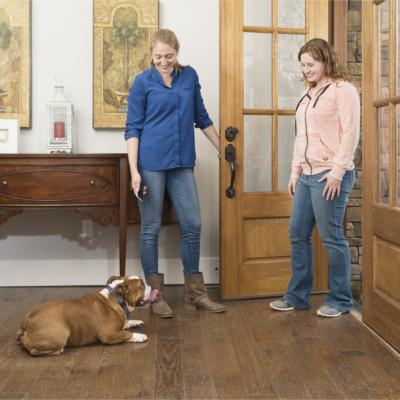
PetSafe® Expert
Stacy N. Hackett
Dispelling Myths About Static Correction
Sometimes your pet dog needs a little help overcoming a behavior that can be dangerous, such as rushing out onto a busy street, or annoying, such as jumping up on visitors. Consistent training can help your dog stop bad habits and learn new behaviors, and this training can be enhanced by static correction.
What Is Static Correction?
Simply put, static correction is a mild, harmless electric stimulation delivered by a collar (sometimes called "shock collar" or "ecollar") to attract your dog's immediate attention. A static collar with contact points (also called "probes") transmits the electric stimulation to the dog's skin in response to cues administered by the owner via a handheld controller. The dog experiences a tingling sensation—similar to what you may experience with "static electricity"—that temporarily startles him, interrupting an inappropriate or undesired behavior or reinforcing a desired behavior. A static collar can be used in both indoor and outdoor situations.

Typical misbehaviors that can be corrected with proper static correction training include:
- Jumping up on people
- Digging
- Chasing
- Running into the street
- Running out of the yard
- Jumping on furniture
- Destructive chewing
- Eating inappropriate items
Typical basic commands that can be reinforced with proper static correction training include:
- "Come"
- "Sit"
- "Heel"
- "Down"
How Does Static Correction Work?
A static collar contains two elements: a handheld remote controller that transmits a radio signal, and a collar that receives the radio signal. (Other static correction collars, such as "bark collars," come with just the collar unit. This article will focus on remote-controlled collars.) Many collars can be set to deliver a warning tone, a warning vibration or electronic pulse, or a combination of these. The owner or trainer also typically has the option to adjust the level or intensity of the electronic pulse as necessary during training.

Timing is important when training a dog. Your pet needs an immediate response to his inappropriate behavior or he may not know exactly which behavior you find undesirable. By using a static collar in a training program, you can immediately correct your dog's behavior even from a distance. Some collars will receive a signal from as many as several miles away. For example, if you see your dog jump up on a visitor while you are standing across the house in another room, you can send a signal to the collar immediately. The unpleasant pulse or tone will interrupt the behavior, and the dog will begin to associate the behavior of jumping up on a person with the pulse or tone.
As with any training program or method, consistency is key. After all, if you want your dog to consistently refrain from an undesired behavior--say, chasing the cat--you need to model that consistency when training him not to chase the cat. Inconsistent enforcement of a rule will confuse your dog and may make him think that the behavior is okay in certain circumstances.
Keep in mind that a static collar is just one tool in a training program. By responding positively to your dog's good behavior, you will reinforce the behavior you want him to demonstrate all the time. Your dog wants to please you--by communicating your desires simply and often, you help him do so.
Is Static Correction Safe?
It is normal to wonder if the pulse delivered by a static collar is safe for your dog. When you first bring home a new static collar, you can try it out on your inner forearm to feel the pulse your dog will feel. The feeling is much like what you may experience when you touch something metal after walking across carpet in your socks. A good static collar will allow you to adjust the intensity of the pulse your dog will feel. Some collars have just a few levels, while others will allow you to fine tune the static stimulation from a level of 1 to 100. Some collars even feature 127 levels. No matter what setting the collar is adjusted to, however, the electric pulse will not burn your pet's skin. Remember, too, that your dog's fur and thicker skin may somewhat deaden the same sensation you feel on your bare skin.
For safety's sake, make sure the static collar you select for your dog is properly fitted to his size, resting snugly high on his neck near his ears. Don't secure it too tightly; you should be able to slip two fingers between the collar and your dog's skin. Be sure to read all the operating instructions and user's manual thoroughly to ensure you use the collar properly. You want to make sure the training experience is successful for both you and your dog.
Get Email Updates
Subscribe to the latest news, promotions, & more from PetSafe® brand.
Sign up today for the latest news, promotions, and more from PetSafe® brand.


